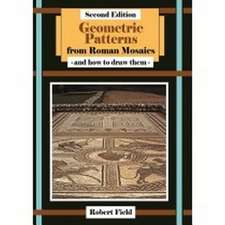Arabic Geometrical Pattern and Design: Dover Pictorial Archive
Autor J. Bourgoinen Limba Engleză Paperback – 24 mar 1974
This book contains 190 examples exhibiting the wide range of Islamic geometrical art: hexagon designs, octagon designs, dodecagon designs, combinations of stars and rosettes (of many variations), combinations of squares and octagons, heptagon designs, and pentagon designs. These fundamental shapes give rise to hundreds of different designs, and merely altering an angle or curving a straight line can create an entirely new pattern. When transferred to metal, wood, stucco, mosaic, and paint, these patterns make up the elaborate ornamentation for which Arabic architecture is noted, and twenty-eight examples of actual applications from Cairo and Damascus are included: sanctuary doors, openwork windows, inlaid marble pavements, and ceilings.
The reader may wish to try his own hand at drawing patterns, to which purpose dotted construction lines are given for sections of the plates. Artists and designers will appreciate this book as a valuable source for Islamic art and design, which they may use directly or vary at will, and with the added use of color they will find that striking and beautiful results can often be achieved.
Preț: 86.37 lei
Preț vechi: 98.97 lei
-13% Nou
Puncte Express: 130
Preț estimativ în valută:
16.53€ • 17.19$ • 13.83£
16.53€ • 17.19$ • 13.83£
Carte disponibilă
Livrare economică 22 februarie-01 martie
Livrare express 08-14 februarie pentru 49.70 lei
Preluare comenzi: 021 569.72.76
Specificații
ISBN-13: 9780486229249
ISBN-10: 0486229246
Pagini: 208
Ilustrații: illustrations
Dimensiuni: 208 x 277 x 18 mm
Greutate: 0.66 kg
Ediția:Revised
Editura: Dover Publications
Seria Dover Pictorial Archive
Locul publicării:United States
ISBN-10: 0486229246
Pagini: 208
Ilustrații: illustrations
Dimensiuni: 208 x 277 x 18 mm
Greutate: 0.66 kg
Ediția:Revised
Editura: Dover Publications
Seria Dover Pictorial Archive
Locul publicării:United States
Descriere
Nearly 200 examples exhibit the wide range of Islamic art, including hexagon and octagon designs, combinations of stars and rosettes, and many variations on other geometric patterns. Twenty-eight examples from traditional sources in Cairo and Damascus include sanctuary doors, openwork windows, and inlaid marble pavements and ceilings.
Textul de pe ultima copertă
By forbidding the representation of the human figure, the Mohammedan religion helped push Islamic art along a path much different from that of traditional European art. European abounds with perspective renderings of figures and landscapes, while Islamic translates artistic impulse into elaborate geometric patterns and linear designs. Through centuries of practicing this purely abstract art, Muslim artists have perfected it to an incomparable elegance.
This book contains 190 examples exhibiting the wide range of Islamic geometrical art: hexagon designs, octagon designs, dodecagon designs, combinations of stars and rosettes (of many variations), combinations of squares and octagons, heptagon designs, and pentagon designs. These fundamental shapes give rise to hundreds of different designs, and merely altering an angle or curving a straight line can create an entirely new pattern. When transferred to metal, wood, stucco, mosaic, and paint, these patterns make up the elaborate ornamentation for which Arabic architecture is noted, and twenty-eight examples of actual applications from Cairo and Damascus are included: sanctuary doors, openwork windows, inlaid marble pavements, and ceilings.
The reader may wish to try his own hand at drawing patterns, to which purpose dotted construction lines are given for sections of the plates. Artists and designers will appreciate this book as a valuable source for Islamic art and design, which they may use directly or vary at will, and with the added use of color they will find that striking and beautiful results can often be achieved.
This edition contains all the plates from "Les Elements de l'art arabe: le trait des entrelacs, " originally published in 1879.
This book contains 190 examples exhibiting the wide range of Islamic geometrical art: hexagon designs, octagon designs, dodecagon designs, combinations of stars and rosettes (of many variations), combinations of squares and octagons, heptagon designs, and pentagon designs. These fundamental shapes give rise to hundreds of different designs, and merely altering an angle or curving a straight line can create an entirely new pattern. When transferred to metal, wood, stucco, mosaic, and paint, these patterns make up the elaborate ornamentation for which Arabic architecture is noted, and twenty-eight examples of actual applications from Cairo and Damascus are included: sanctuary doors, openwork windows, inlaid marble pavements, and ceilings.
The reader may wish to try his own hand at drawing patterns, to which purpose dotted construction lines are given for sections of the plates. Artists and designers will appreciate this book as a valuable source for Islamic art and design, which they may use directly or vary at will, and with the added use of color they will find that striking and beautiful results can often be achieved.
This edition contains all the plates from "Les Elements de l'art arabe: le trait des entrelacs, " originally published in 1879.
























